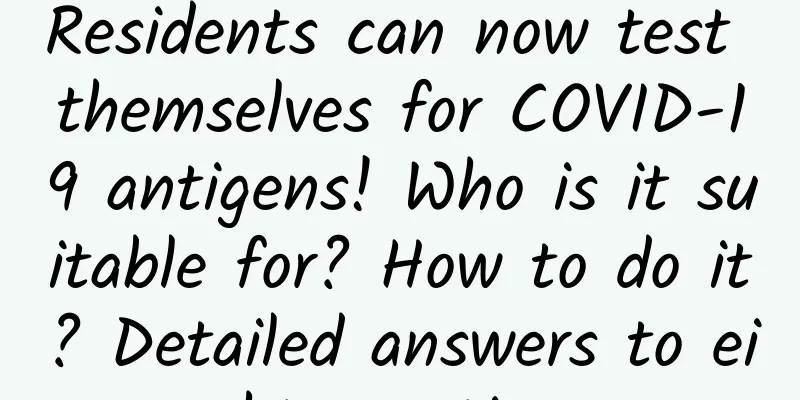Residents can now test themselves for COVID-19 antigens! Who is it suitable for? How to do it? Detailed answers to eight questions

|
|||| On March 11, the National Health Commission’s official website released the “Notice on Printing and Distributing the Application Plan for Antigen Testing of New Coronavirus (Trial)” (hereinafter referred to as the “Notice”), indicating that it has decided to add antigen testing as a supplement to nucleic acid testing, and organized the formulation of the “Application Plan for Antigen Testing of New Coronavirus (Trial)” (hereinafter referred to as the “Trial Plan”). (>>Detailed Plan) Just one day later, five new crown antigen self-test products were officially launched. On March 12, the National Medical Products Administration issued a notice approving the change of the new crown antigen product self-test application application of Nanjing Novozymes, Beijing Jinwolf, Shenzhen BGI, Guangzhou Wondfo Biologics, and Beijing Huaketai Biologics. Since then, five new crown antigen self-test products have been officially launched. In addition to nucleic acid testing, the new coronavirus self-testing policy has also been officially implemented. The pilot plan provides a detailed introduction to the application of antigen testing in primary medical and health institutions, quarantined observation personnel, and community residents. According to the plan, the use of antigen testing in primary medical and health institutions involves professional personnel to collect samples, while the use of quarantined observation personnel and community residents involves self-testing. This is the first time that the relevant policies for community residents to self-test for COVID-19 have been clarified. The reporter sorted out the above 8 key self-test questions based on public information: ◈ ◈ ◈ 01. Can self-test results replace nucleic acid? cannot. The notice made it clear that after research, the State Council's Joint Prevention and Control Mechanism for the Novel Coronavirus Pneumonia Epidemic decided to add antigen testing as a supplement to nucleic acid testing. Nucleic acid testing is still the basis for confirming novel coronavirus infection. The "Basic Requirements and Procedures for Self-Testing for New Coronavirus Antigens" in the pilot program also emphasizes that antigen testing is generally used during the acute infection period, that is, sample testing within 7 days of the onset of symptoms in suspected people. Both positive and negative results of antigens in suspected people should be further tested for nucleic acid. Positive results can be used for early diversion and rapid management of suspected people, but cannot be used as a basis for confirming new coronavirus infection. ◈ ◈ ◈ 02.Who can self-test? Three groups of people: ① Those who visit primary medical and health institutions with respiratory and fever symptoms and have had symptoms for less than 5 days; ② Persons under quarantine observation, including those under home quarantine observation, close contacts and secondary close contacts, entry quarantine observation, and those in sealed-off and controlled areas; ③Community residents who have the need for antigen self-testing. ◈ ◈ ◈ 03. How to determine the frequency of self-testing for COVID-19? It depends on the crowd. For those under quarantine and observation, nucleic acid testing shall be carried out in accordance with the requirements of the current relevant prevention and control plan during the quarantine and observation period, and antigen self-testing shall be conducted once a day for the first 5 days. For community residents, those who need self-testing can purchase it and do the test themselves. Residents with negative antigen test and no symptoms can be closely observed and undergo antigen test or nucleic acid test when necessary; residents with symptoms are advised to go to a medical institution with a fever clinic as soon as possible for nucleic acid test; if it is inconvenient to see a doctor, they should self-isolate at home, avoid going out, and do antigen self-test once a day for 5 consecutive days. ◈ ◈ ◈ 04.What are the precautions for self-testing? There are three steps in antigen self-testing. First, preparation before antigen self-testing. 1. Wash your hands. Use running water or hand disinfectant to wash your hands. 2. Understand the testing process. Carefully read the instructions for the antigen self-test kit and the precautions for antigen self-test. 3. Reagent preparation. Check whether the antigen self-test reagent is within the shelf life, and check whether the contents of the nasal swab, sampling tube, test card, etc. are missing or damaged. If the reagent is expired or the contents of the reagent are missing or damaged, the test reagent should be replaced in time. 4. Confirm the test requirements for ambient temperature and humidity. Colloidal gold test strips are generally tested at room temperature of 14°C-30°C, avoiding abnormal test results caused by excessive cold, heat or humidity. After removing the packaging, place the antigen test card in a flat, clean place. Second, sample collection. 1. People aged 14 and above can take nasal swab samples by themselves. Self-examiners should first blow their nose with toilet paper. Carefully unpack the nasal swab and avoid touching the swab head with your hands. Then tilt your head slightly, hold the tail of the swab in one hand and stick it into one nostril, slowly move 1-1.5 cm backward along the bottom of the inferior nasal passage, and then stick it into the nasal cavity and rotate it for at least 4 times (staying for at least 15 seconds), and then use the same swab to repeat the same operation on the other nostril. 2. Self-testers aged 2-14 should be sampled by other adults. When sampling, first blow your nose with toilet paper, then tilt your head slightly. The sampler carefully unpacks the outer packaging of the nasal swab, avoids touching the swab head with your hands, gently supports the head of the person being sampled with one hand, and holds the swab in one nostril with the other hand, slowly penetrates 1 cm backward along the bottom of the inferior nasal passage, and then rotates the nasal cavity for at least 4 circles (staying for no less than 15 seconds), and then uses the same swab to repeat the same operation on the other nasal cavity. Third, antigen testing. 1. According to the reagent instructions, place the nasal swab immediately after sample collection in the sampling tube. The swab head should be rotated and mixed in the preservation solution for at least 30 seconds. At the same time, squeeze the swab head through the outer wall of the sampling tube by hand at least 5 times to ensure that the sample is fully eluted in the sampling tube. 2. Use your hands to squeeze the liquid out of the swab head through the outer wall of the sampling tube, and then discard the swab. After the sampling tube is capped, drop the liquid vertically into the sample hole of the test card. 3. According to the reagent instructions, wait for a certain period of time before interpreting the results. Positive result: Both "C" and "T" show red or purple bands, and the color of the "T" band can be dark or light, which is a positive result. Negative result: A red or purple band appears at "C" and no band appears at "T". Invalid result: No red or purple band appears at "C", regardless of whether a band appears at "T". The result is invalid and a new test strip needs to be taken and retested. ◈ ◈ ◈ 05. How to deal with the used self-test reagents? The same is true for different groups of people. Isolation and observation personnel: Regardless of the test result being negative or positive, all used sampling swabs, sampling tubes, test cards, etc. shall be placed in sealed bags and handled by management personnel in accordance with medical waste or according to procedures. Community residents: If the test result is negative, all used nasal swabs, sampling tubes, test cards, etc. should be placed in sealed bags and disposed of as general waste; if the test result is positive, they should be handed over to the medical institution and disposed of as medical waste when the person is transferred. ◈ ◈ ◈ 06.Where can I buy self-test kits? On March 12, the latest pending information released on the government portal of the National Medical Products Administration showed that the medical device approval documents (changes) obtained by 4 new crown antigen detection kit products were pending, and the approval time was March 12, involving 4 companies, including Nanjing Novozymes Biotech Co., Ltd. (Novozymes, 688105), a wholly-owned subsidiary of Nanjing Novozymes Medical Technology Co., Ltd., Guangzhou Wondfo Biotech Co., Ltd. (Wondfo Biotech, 300482), Shenzhen BGI Gene Source Pharmaceutical Technology Co., Ltd., a subsidiary of BGI (300676), and Beijing Kingwolf Bioengineering Technology Co., Ltd. Together with Beijing Huaketai, which was approved for change the day before, the number of manufacturers approved for change has increased to 5. Therefore, in the near future there will be COVID-19 self-test kits available for purchase in the country. ◈ ◈ ◈ 07. How much does the self-test kit cost? Referring to the prices of domestic self-testing kits overseas, at the end of 2021, iHealth mentioned in its response to investors on an interactive platform that the company's new crown antigen test kit is currently officially sold on Amazon in the United States at US$6.99 per person, and there are currently no plans to reduce prices. People under quarantine and observation do not need to pay for the testing reagents they need. According to the pilot plan, the administrative departments that organize quarantine and observation (such as communities, towns, villages, quarantine points, etc.) are responsible for the procurement, distribution, and management of antigen testing reagents. ◈ ◈ ◈ 08.What practical uses do the test results have? The National Health Commission stated that antigen testing can be used as a supplementary means to screen specific populations, which is conducive to improving the ability of "early detection". It is not yet clear whether the results of the new crown antigen self-test can be used as a travel certificate, and it is still waiting for further refinement by relevant departments. (Source: Beijing Daily WeChat Official Account) |
<<: What are cashews? What are the benefits of eating cashews?
Recommend
What should women do if they have kidney deficiency? There are ways to regulate kidney deficiency
When it comes to kidney deficiency, many people&#...
Women can do this morning and evening to avoid menstrual disorders!
Some people say: Menstruation is like salary, it ...
How to stimulate lactation? These methods are very effective
Many women find that they do not have enough milk...
Precautions for frequent uterine contractions at 32 weeks of pregnancy
After pregnancy, from the early stage to the midd...
How long will it take for menstruation to come if I have chest pain?
Many women will encounter this situation, when me...
Can people with gynecological inflammation eat Maca?
Maca has been sought after by many people in rece...
Is ovarian teratoma likely to recur?
Ovarian teratoma is a tumor that is prone to recu...
The reason why there is a pimple next to the vulva
Women's reproductive health has always been a...
Treatment of cervical cysts, Chinese medicine and diet therapy
Cervical cyst is a common cervical disease in wom...
What are the benefits of drinking black wolfberry for women
Women all love beauty, and many women will choose...
Can acute mastitis be cured by puncture and extraction of pus?
Acute mastitis is a common disease among breastfe...
Women's full body check-up must do items
Women's Day is coming soon, and women in toda...
Which department should women go to for examination if their hands are numb?
Cervical spondylosis can cause numbness in the ha...
How to calculate pregnancy days
When you are pregnant, you will have a due date. ...
How to restore sagging breasts after childbirth?
When a woman gives birth, her body will undergo s...









